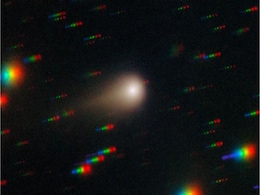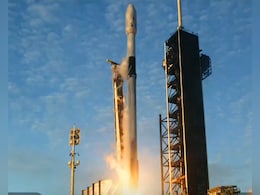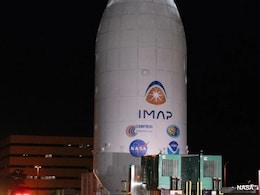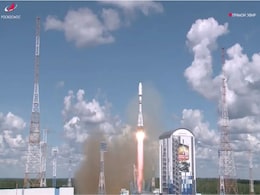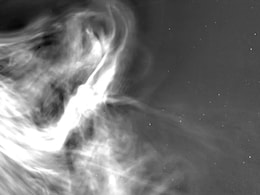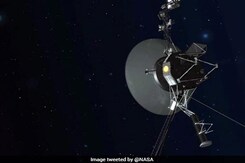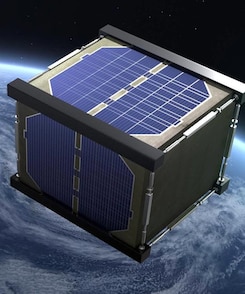Space Probe
- All
- News
- Videos
- Web Stories
-

Scientist Claims Alien Probes May Be In Plain Sight, Observing Earth's Growing Intelligence
Ellery suggested that building a nuclear reactor on the Moon could yield chemical signatures that could be explored in the future.
-

Blue Origin Delays NASA Mars Launch Amid Weather and FAA Restrictions
Blue Origin has postponed the launch of NASA’s twin ESCAPADE Mars probes due to bad weather and new FAA restrictions on daytime launches during the U.S. government shutdown. The mission, now targeting Nov. 12, will study how solar wind stripped away Mars’s atmosphere. Blue Origin is seeking an FAA exemption to proceed with the launch.
-

NASA’s ESCAPADE Mission Will Send Twin Probes to Uncover Mars’s Atmospheric Secrets
NASA’s ESCAPADE mission will launch twin mini-satellites, Blue and Gold, to Mars aboard Blue Origin’s New Glenn. The probes will study how solar wind stripped away Mars’s atmosphere and water, helping scientists understand the Red Planet’s lost climate and its transformation into the dry world we see today.
-

Meteorite May Have Hit Moving Car in Australia, Scientists Investigate
A South Australian man’s car windshield was struck and melted by a mysterious object, prompting an investigation by the South Australian Museum. If confirmed as a meteorite, it would be the first known instance of one hitting a moving vehicle. Experts say only lab analyses can determine whether it was a rock or space debris.
-

Mars and Jupiter Probes Set to Monitor Interstellar Comet 3I/ATLAS During Its Sun Approach This Month
The European Space Agency (ESA) is keeping a close eye on the Interstellar Comet 3I/ATLAS on its journey through the solar system. A spacecraft, specially designed for the Jupiter and Mars missions, will monitor the interstellar comet. Notably, this is the third known interstellar object that has marked its way through the solar system and is conti...
-

SpaceX Launches IMAP, CGO, SWFO-L1 to Probe Solar Frontier and Space Weather
A Falcon 9 lifted off from Kennedy Space Center on Sept. 24, 2025, carrying NASA’s IMAP, CGO, and SWFO-L1 spacecraft. The mission aims to chart the heliosphere’s boundary, monitor Earth’s geocorona, and deliver constant space-weather alerts, protecting satellites and astronauts while expanding knowledge of the solar system’s outer edge.
-

What Is Heliosphere? NASA's New Mission To Study Sun's Protective Bubble
NASA launched the Interstellar Mapping and Acceleration Probe (IMAP) spacecraft from Kennedy Space Center in Florida on Wednesday, September 24.
-

NASA Detects Strange Gamma-Ray Burst That Defies 50 Years of Expectations
Astronomers have spotted GRB 250702B, a gamma-ray burst that erupted several times over two days—something never seen before. Detected by NASA’s Fermi and China’s Einstein Probe, the event defies current models of collapsing stars or black holes, hinting at an entirely new cosmic phenomenon.
-

TARS: Sunlight-Powered Space Slingshot Could Propel Tiny Probes to the Stars
Astronomer David Kipping has proposed TARS, a sunlight-driven space slingshot. Using reflective panels spun in space, it can fling small probes at escape speed. Though Alpha Centauri is over a thousand years away, this simple, fuel-free idea could pave the way for future interstellar missions.
-

NASA and NOAA Set to Launch Solar Probes for Space Weather Forecasting
In Sept. 2025, NASA and NOAA will launch three spacecraft aboard a Falcon 9 to the Sun–Earth L1 point. IMAP will map the heliosphere’s edge, the Carruthers Geocorona Observatory will study Earth’s exosphere, and SWFO-L1 will deliver real-time solar storm warnings. Together, they aim to improve space-weather science and safeguard technology on...
-

ESA’s JUICE Probe Uses Venus Flyby to Stay on Track for Jupiter’s Icy Moons
The European Space Agency’s Jupiter Icy Moons Explorer (JUICE) successfully executed a Venus flyby on August 31, 2025, using the planet’s gravity to speed toward Jupiter. Engineers overcame a brief antenna glitch before the maneuver, and the spacecraft endured Venus’s intense heat by shielding itself with its high-gain antenna.
-

NASA’s PUNCH Mission Completes Final Orbit Manoeuvres, Opens Early Sun Data to the Public
NASA’s PUNCH mission has reached full operational status, enabling continuous monitoring of the Sun and solar wind from multiple vantage points around Earth. This collaborative effort complements other major solar missions and promises valuable insights into the Sun–Earth connection. Early public release of PUNCH’s science data marks an excit...
-

NASA to Live Stream SpaceX Crew-11 Launch Docking, Know How to Watch Online
On July 25, 2025, Russia launched two Ionosfera-M satellites and Iran’s Nahid-2 communication satellite aboard a Soyuz-2.1b rocket from Vostochny. The new Ionosfera-M probes expand Russia’s space weather tracking constellation, while Nahid-2 reflects Iran’s space ambitions. The joint launch highlights deepening space collaboration between Mos...
-

China’s Tianwen 2 Probe Snaps Striking Views of Earth and Moon While En Route to Asteroid
China’s Tianwen 2 spacecraft, now millions of kilometers from Earth, captured distant images of Earth and the moon as it journeys to asteroid Kamo'oalewa. Set to collect samples by 2026 and return them in 2027, the mission could reveal insights into the solar system’s formation—before continuing on to a second deep-space target, comet 311P/PA...
-

NASA’s Parker Probe Sends Closest-Ever Images from Inside the Sun’s Corona
NASA’s Parker Solar Probe has achieved a solar milestone by capturing the closest-ever images of the Sun, taken just 3.8 million miles from its surface in December 2024. These WISPR images reveal unprecedented details of the corona, solar wind, and CME collisions. Scientists say this breakthrough will improve our ability to forecast space weather...
-

Scientist Claims Alien Probes May Be In Plain Sight, Observing Earth's Growing Intelligence
Ellery suggested that building a nuclear reactor on the Moon could yield chemical signatures that could be explored in the future.
-

Blue Origin Delays NASA Mars Launch Amid Weather and FAA Restrictions
Blue Origin has postponed the launch of NASA’s twin ESCAPADE Mars probes due to bad weather and new FAA restrictions on daytime launches during the U.S. government shutdown. The mission, now targeting Nov. 12, will study how solar wind stripped away Mars’s atmosphere. Blue Origin is seeking an FAA exemption to proceed with the launch.
-

NASA’s ESCAPADE Mission Will Send Twin Probes to Uncover Mars’s Atmospheric Secrets
NASA’s ESCAPADE mission will launch twin mini-satellites, Blue and Gold, to Mars aboard Blue Origin’s New Glenn. The probes will study how solar wind stripped away Mars’s atmosphere and water, helping scientists understand the Red Planet’s lost climate and its transformation into the dry world we see today.
-

Meteorite May Have Hit Moving Car in Australia, Scientists Investigate
A South Australian man’s car windshield was struck and melted by a mysterious object, prompting an investigation by the South Australian Museum. If confirmed as a meteorite, it would be the first known instance of one hitting a moving vehicle. Experts say only lab analyses can determine whether it was a rock or space debris.
-

Mars and Jupiter Probes Set to Monitor Interstellar Comet 3I/ATLAS During Its Sun Approach This Month
The European Space Agency (ESA) is keeping a close eye on the Interstellar Comet 3I/ATLAS on its journey through the solar system. A spacecraft, specially designed for the Jupiter and Mars missions, will monitor the interstellar comet. Notably, this is the third known interstellar object that has marked its way through the solar system and is conti...
-

SpaceX Launches IMAP, CGO, SWFO-L1 to Probe Solar Frontier and Space Weather
A Falcon 9 lifted off from Kennedy Space Center on Sept. 24, 2025, carrying NASA’s IMAP, CGO, and SWFO-L1 spacecraft. The mission aims to chart the heliosphere’s boundary, monitor Earth’s geocorona, and deliver constant space-weather alerts, protecting satellites and astronauts while expanding knowledge of the solar system’s outer edge.
-

What Is Heliosphere? NASA's New Mission To Study Sun's Protective Bubble
NASA launched the Interstellar Mapping and Acceleration Probe (IMAP) spacecraft from Kennedy Space Center in Florida on Wednesday, September 24.
-

NASA Detects Strange Gamma-Ray Burst That Defies 50 Years of Expectations
Astronomers have spotted GRB 250702B, a gamma-ray burst that erupted several times over two days—something never seen before. Detected by NASA’s Fermi and China’s Einstein Probe, the event defies current models of collapsing stars or black holes, hinting at an entirely new cosmic phenomenon.
-

TARS: Sunlight-Powered Space Slingshot Could Propel Tiny Probes to the Stars
Astronomer David Kipping has proposed TARS, a sunlight-driven space slingshot. Using reflective panels spun in space, it can fling small probes at escape speed. Though Alpha Centauri is over a thousand years away, this simple, fuel-free idea could pave the way for future interstellar missions.
-

NASA and NOAA Set to Launch Solar Probes for Space Weather Forecasting
In Sept. 2025, NASA and NOAA will launch three spacecraft aboard a Falcon 9 to the Sun–Earth L1 point. IMAP will map the heliosphere’s edge, the Carruthers Geocorona Observatory will study Earth’s exosphere, and SWFO-L1 will deliver real-time solar storm warnings. Together, they aim to improve space-weather science and safeguard technology on...
-

ESA’s JUICE Probe Uses Venus Flyby to Stay on Track for Jupiter’s Icy Moons
The European Space Agency’s Jupiter Icy Moons Explorer (JUICE) successfully executed a Venus flyby on August 31, 2025, using the planet’s gravity to speed toward Jupiter. Engineers overcame a brief antenna glitch before the maneuver, and the spacecraft endured Venus’s intense heat by shielding itself with its high-gain antenna.
-

NASA’s PUNCH Mission Completes Final Orbit Manoeuvres, Opens Early Sun Data to the Public
NASA’s PUNCH mission has reached full operational status, enabling continuous monitoring of the Sun and solar wind from multiple vantage points around Earth. This collaborative effort complements other major solar missions and promises valuable insights into the Sun–Earth connection. Early public release of PUNCH’s science data marks an excit...
-

NASA to Live Stream SpaceX Crew-11 Launch Docking, Know How to Watch Online
On July 25, 2025, Russia launched two Ionosfera-M satellites and Iran’s Nahid-2 communication satellite aboard a Soyuz-2.1b rocket from Vostochny. The new Ionosfera-M probes expand Russia’s space weather tracking constellation, while Nahid-2 reflects Iran’s space ambitions. The joint launch highlights deepening space collaboration between Mos...
-

China’s Tianwen 2 Probe Snaps Striking Views of Earth and Moon While En Route to Asteroid
China’s Tianwen 2 spacecraft, now millions of kilometers from Earth, captured distant images of Earth and the moon as it journeys to asteroid Kamo'oalewa. Set to collect samples by 2026 and return them in 2027, the mission could reveal insights into the solar system’s formation—before continuing on to a second deep-space target, comet 311P/PA...
-

NASA’s Parker Probe Sends Closest-Ever Images from Inside the Sun’s Corona
NASA’s Parker Solar Probe has achieved a solar milestone by capturing the closest-ever images of the Sun, taken just 3.8 million miles from its surface in December 2024. These WISPR images reveal unprecedented details of the corona, solar wind, and CME collisions. Scientists say this breakthrough will improve our ability to forecast space weather...




